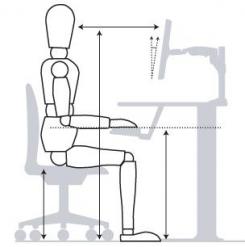
Base
What to Look for:
- Casters (aka wheels) appropriate for type of floor (i.e. hard wheel type for carpet vs. soft wheel for hard floor)
- 5-point base for increased stability
- Swivel base
Avoid: Stationary chairs that are non-adjustable such as ‘stacker chairs’, ‘guest chairs’ and stools or sit/stand chairs that are appropriate for standing height desks.







